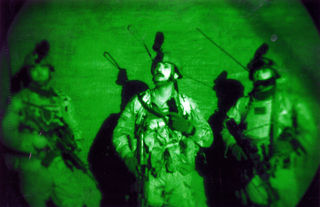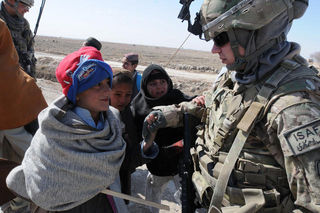More than 1.7 million of the 2.6 million soldiers deployed to Iraq and Afghanistan have transitioned back to civilian life with another one million expected to do so over the next handful of years. Over the past couple weeks, part 1 and 2 of this series discussed the growing divide between the civilian and military population and the complexity of the transition out of the Armed Forces. The widespread disavowal of traditional masculinity, the necessity of these very traits in warfare, and the resulting dissonance were put forth as possible sources of stress during reintegration.

It is worthy of repetition, that the narrowing of what is acceptably masculine imposes judgment, where there should be none. In demonizing masculinity, we prevent discourse, polarize, and shame something that is, in large part, biologically determined.
Most masculine traits are related to levels of testosterone. On average, men’s testosterone levels are ten to forty-five times higher than women’s. Military training fosters competitiveness and with some indications that competition may increase testosterone, it stands to reason that women who serve also adopt or prioritize similar masculine traits, to the benefit of themselves and their unit. Again, masculinity does not confer sex but men, like it or not, personify masculinity more frequently and extensively than women.
In forcing men to deny their manhood, we lose the opportunity to meaningfully engage around the governance of nature, acceptance of self, and masculinity’s essential role in society. Forced disownment of masculine traits (i.e. competitiveness, protectiveness, aggressiveness) damages men’s capacity to regulate, oversee, and use those traits in a productive, mindful manner. By forcing their denial, we also indirectly encourage relinquishment of responsibility in recognizing the shadow side of these traits.
Disclaimer: shadow side does not mean toxic.

"Everyone carries a shadow and the less it is embodied in the individual's conscious life, the blacker and denser it is." -Carl Jung
Accepting that there are very real negatives to positive masculine traits is not surrendering to the notion that masculinity is bad. It’s an acknowledgement that context matters. That which serves a warfighter well in the chaos of battle, may not translate effectively into the navigation of an argument with a romantic partner.
Someone recently told me that he trained his men not to yell for medic when injured during combat, to instead provide self-aid, and assess the situation. This makes tactical and operational sense, and we must ask ourselves, what does that look like in the civilian world-- where bullets aren’t flying, no one’s bleeding, and success is no longer defined by concrete, objective-oriented end states?
Isolation. It looks like men and women trying to go it alone, toughing it out--not asking for help when help is what they ultimately need. Let’s abolish the idea that reliance is negative. Fire team, sniper and spotter, jumpmaster and safety, junior and senior, battle buddy. The military encourages, promotes, and necessitates reliance on other people. The notion that once you transition out, you no longer need support, that’s toxic. That is what is lethal.
Due to the intensity of socialization in the military, men merge what it means to be a soldier and a man. This unification of identity can make for a particularly potent blend. The result: men reluctant, unwilling, and potentially unable to experience emotions they learned to repeatedly suppress, even after they transition out of service.

This is not unique to military men. Military women also value competition and power, hiding weakness, self-reliance, and emotional control. Yet, where men are by and large expected to act this way, women are not. Disturbingly, the increase in suicide rates among women veterans doubled between 2001 and 2014 in comparison to their civilian counterparts (85% increase during this time period for Veterans versus 40% for civilians).
It is assumed that men enjoy and expect to be needed, we need to normalize that’s it’s okay for men to need in return. For military women, same. A military woman can be strong, independent, and self-reliant and possess an intense desire to be taken care of.
It is hard to overstate the value of masculine characteristics like stoicism and emotional control, feelings of invulnerability, awareness of the potential value of aggression, and self-reliance in the effective function of our military. The societal move towards a dismissal of traditional masculine traits as toxic, across all contexts, smacks of intolerance and appears to be an unconscious rejection of our men and women in uniform. In the service of destigmatizing, it may be farther stigmatizing for a potentially at-risk population and prevent those who identify with such traits to present for treatment.
For the military member or veteran: Capability does not always begin and end with physicality. Emotions don’t make you weak, they make you human and confer evolutionary benefits. Use that which made you an asset in service, to your advantage. Attempt to transform physical courage into psychological courage, so you can live the life you desire.
For the mental health care provider: Find ways to ensure that services are geared towards and attractive to men who normally do not present for treatment. Getting them in the door is the primary hurdle. Once there, expect difficulty in processing and expressing emotion. Do not over-pathologize what has served them well and possibly saved their life.
References
Lorber, W., & Garcia, H. A. (2010). Not supposed to feel this: Traditional masculinity in psychotherapy with male veterans returning from Afghanistan and Iraq. Psychotherapy: Theory, Research, Practice, Training, 47(3), 296.
Pirkis, J., Spittal, M. J., Keogh, L., Mousaferiadis, T., & Currier, D. (2017). Masculinity and suicidal thinking. Social psychiatry and psychiatric epidemiology, 52(3), 319-327.
US Department of Veterans Affairs (VA) and Department of Defense. Suicide Among Veterans and Other Americans. VA Website. 2016. http://www.mentalhealth.va.gov/docs/2016suicidedatareport.pdf. Accessed 8 December 2016.
van Anders, S. M., Steiger, J., & Goldey, K. L. (2015). Effects of gendered behavior on testosterone in women and men. Proceedings of the National Academy of Sciences, 112(45), 13805-13810.
Zoli, C, Maury, R., and Fay, D. (2015). Missing Perspectives: Servicemembers’ Transition from Service to Civilian Life. Syracuse, NY: Syracuse University, Institute for Veterans and Military Families.




